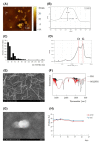Graphene Oxide Nanoplatforms to Enhance Cisplatin-Based Drug Delivery in Anticancer Therapy
- PMID: 35889596
- PMCID: PMC9321599
- DOI: 10.3390/nano12142372
Graphene Oxide Nanoplatforms to Enhance Cisplatin-Based Drug Delivery in Anticancer Therapy
Abstract
Chemotherapeutics such as platinum-based drugs are commonly used to treat several cancer types, but unfortunately, their use is limited by several side effects, such as high degradation of the drug before entering the cells, off-target organ toxicity and development of drug resistance. An interesting strategy to overcome such limitations is the development of nanocarriers that could enhance cellular accumulation in target cells in addition to decreasing associated drug toxicity in normal cells. Here, we aim to prepare and characterize a graphene-oxide-based 2D nanoplatform functionalised using highly branched, eight-arm polyethylene-glycol, which, owing to its high number of available functional groups, offers considerable loading capacity over its linear modalities and represents a highly potent nanodelivery platform as a versatile system in cancer therapy. The obtained results show that the GO@PEG carrier allows for the use of lower amounts of Pt drug compared to a Pt-free complex while achieving similar effects. The nanoplatform accomplishes very good cellular proliferation inhibition in osteosarcoma, which is strictly related to increased cellular uptake. This enhanced cellular internalization is also observed in glioblastoma, although it is less pronounced due to differences in metabolism compared to osteosarcoma. The proposed GO@PEG nanoplatform is also promising for the inhibition of migration, especially in highly invasive breast carcinoma (i.e., MDA-MB-231 cell line), neutralizing the metastatic process. The GO@PEG nanoplatform thus represents an interesting tool in cancer treatment that can be specifically tailored to target different cancers.
Keywords: breast cancer; drug delivery systems; glioblastoma; graphene oxide; nanomaterials; nanomedicine; osteosarcoma; platinum-based drug.
Conflict of interest statement
The authors declare no conflict of interest.
Figures









Similar articles
-
A theranostic prodrug delivery system based on Pt(IV) conjugated nano-graphene oxide with synergistic effect to enhance the therapeutic efficacy of Pt drug.Biomaterials. 2015 May;51:12-21. doi: 10.1016/j.biomaterials.2015.01.074. Epub 2015 Feb 14. Biomaterials. 2015. PMID: 25770993
-
In vivo targeting of metastatic breast cancer via tumor vasculature-specific nano-graphene oxide.Biomaterials. 2016 Oct;104:361-71. doi: 10.1016/j.biomaterials.2016.07.029. Epub 2016 Jul 26. Biomaterials. 2016. PMID: 27490486 Free PMC article.
-
Cationic graphene oxide nanoplatform mediates miR-101 delivery to promote apoptosis by regulating autophagy and stress.Int J Nanomedicine. 2018 Oct 1;13:5865-5886. doi: 10.2147/IJN.S162647. eCollection 2018. Int J Nanomedicine. 2018. PMID: 30319254 Free PMC article.
-
Carbon nanotubes for delivery of small molecule drugs.Adv Drug Deliv Rev. 2013 Dec;65(15):1964-2015. doi: 10.1016/j.addr.2013.08.005. Epub 2013 Aug 14. Adv Drug Deliv Rev. 2013. PMID: 23954402 Review.
-
Multifunctionalization of graphene and graphene oxide for controlled release and targeted delivery of anticancer drugs.Am J Transl Res. 2017 Dec 15;9(12):5197-5219. eCollection 2017. Am J Transl Res. 2017. PMID: 29312477 Free PMC article. Review.
Cited by
-
Cytotoxicity of Carbon Nanotubes, Graphene, Fullerenes, and Dots.Nanomaterials (Basel). 2023 Apr 25;13(9):1458. doi: 10.3390/nano13091458. Nanomaterials (Basel). 2023. PMID: 37177003 Free PMC article. Review.
-
Oxidative phosphorylation and breast cancer progression: insights into PGC-1α's role in mitochondrial function.Naunyn Schmiedebergs Arch Pharmacol. 2025 Aug;398(8):9887-9900. doi: 10.1007/s00210-025-04018-w. Epub 2025 Mar 17. Naunyn Schmiedebergs Arch Pharmacol. 2025. PMID: 40095051 Review.
-
Graphene oxide and oxidized carbon nanodiscs as biomedical scaffolds for the targeted delivery of quercetin to cancer cells.Nanoscale Adv. 2024 Apr 17;6(11):2860-2874. doi: 10.1039/d3na00966a. eCollection 2024 May 29. Nanoscale Adv. 2024. PMID: 38817436 Free PMC article.
-
2D and 3D anticancer properties of C2-functionalised glucosamine-Pt (IV) prodrugs based on cisplatin scaffold.Front Chem. 2024 May 6;12:1388332. doi: 10.3389/fchem.2024.1388332. eCollection 2024. Front Chem. 2024. PMID: 38770272 Free PMC article.
-
Orchestrating cancer therapy: Recent advances in nanoplatforms harmonize immunotherapy with multifaceted treatments.Mater Today Bio. 2024 Dec 9;30:101386. doi: 10.1016/j.mtbio.2024.101386. eCollection 2025 Feb. Mater Today Bio. 2024. PMID: 39742149 Free PMC article. Review.
References
-
- World Health Organization—Cancer. 2021. [(accessed on 3 February 2022)]. Available online: https://www.who.int/news-room/fact-sheets/detail/cancer.
Grants and funding
LinkOut - more resources
Full Text Sources
Miscellaneous

